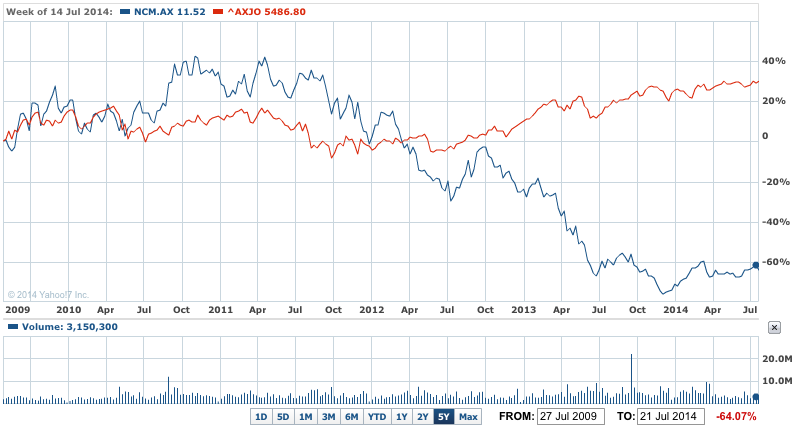Newcrest Mining (NCM) shares took a hammering yesterday as the country’s biggest gold miner revealed a surprising second multi-billion dollar writedown in nearly 13-months.
The shares lost 6.1% to end at $10.79, with the losses growing during the day as investors gloomily examined the update and writedowns.
The news followed the controversial announcement on June 6, 2013 of around $6.23 billion in write downs and losses.
Newcrest said yesterday it hadn’t finished figuring out the final figures of the losses, but indicated they would be between $1.5 and $2.5 billion.
Once again, the pain for Newcrest investors is led by its Lihir (PNG), Telfer (Australia) and Bonikro (Africa) gold mining assets.
Lihir is the most problematic.
In the 2013 writedowns, $3.6 billion involved Lihir and its goodwill (the difference Newcrest paid in 2011 in its $9.2 billion takeover over the actual value of the assets acquired), while there was a further $2.2 billion in goodwill associated with the Bonkiro mine also written off.
NCM vs XJO 5Y – Lihir problems plague Newcrest

Newcrest said yesterday that operating cost assumptions were being revised at Lihir, after running the plant expansion there for a full year.
Lihir was supposed to be another large, low cost gold mine to complement Newcrest’s flagship Cadia mine in NSW.
But Lihir continues to be plagued with operational troubles and is now shaping up as a large, higher cost operation, with lower profitability than previously thought.
And the higher than expected value of the Australian dollar is making times tougher and has forced a review of book values, with Newcrest previously operating under a long-term assumption that the currency would be worth around 80 USc.
It was trading well over 94 USc yesterday, and with no sign of falling back under the 90c level, where it was for a while in 2013.
In yesterday’s statement, Newcrest stressed that the work on book values was not complete, and the final size of the impairments was uncertain.
"The board considers it likely that its review will indicate an impairment of the carrying value of assets in the range of $1.5 billion to $2.5 billion after tax," the miner said in a statement.
The company hinted that it could offset some of the write downs by revaluations of other mining assets.
"There are other assets within the Newcrest portfolio that the Board believes have a market value much greater than their carrying value, including Cadia Valley, Gosowong and Wafi Golpu," the company said yesterday.
The write downs could increase Newcrest’s debt ratio by as much as 6%, meaning the company will have to assure its banks.
Although an impairment has no impact on cash flow, a reduction in book values in the range of A$1.5 billion to A$2.5 billion is estimated to adversely impact gearing by approximately 3% to 6%.
Under current market and operating conditions, the Board remains comfortable with gearing being at this level in the short to medium term given the near term cash flow growth outlook of the Group.
The debt ratio was already hovering around 30% this year and the miner wants that ratio to be closer to 15% in coming years.
That will need some serious funding raising or asset disposals.
Newcrest started the year with a promise to produce between 2 million and 2.3 million ounces of gold; an amount that most analysts thought was very conservative.
In recent months the company has told the market to expect a result toward the higher end of that range.
Gold production guidance for the 2015 financial year has already been published, and Newcrest expects to produce a similar amount to this year – between 2.2 million and 2.4 million ounces.
In the production report yesterday the company said June quarter gold production was 636,736 ounces (85,146 ounces or 15% higher than the March 2014 quarter).
Copper production for the quarter was 22,871 tonnes (1,859 tonnes or 9% higher than the March 2014 quarter).
For the full year, gold production was 2,396,023 ounces (a 14% increase on 2,109,784 ounces in the 2013 financial year) and copper production was 86,118 tonnes (a 7% increase on 80,366 tonnes in the 2013 financial year).
And the company said its All-In Sustaining Cost of $A976/oz ($US897 an ounce) of gold fell 24% from 2013.













